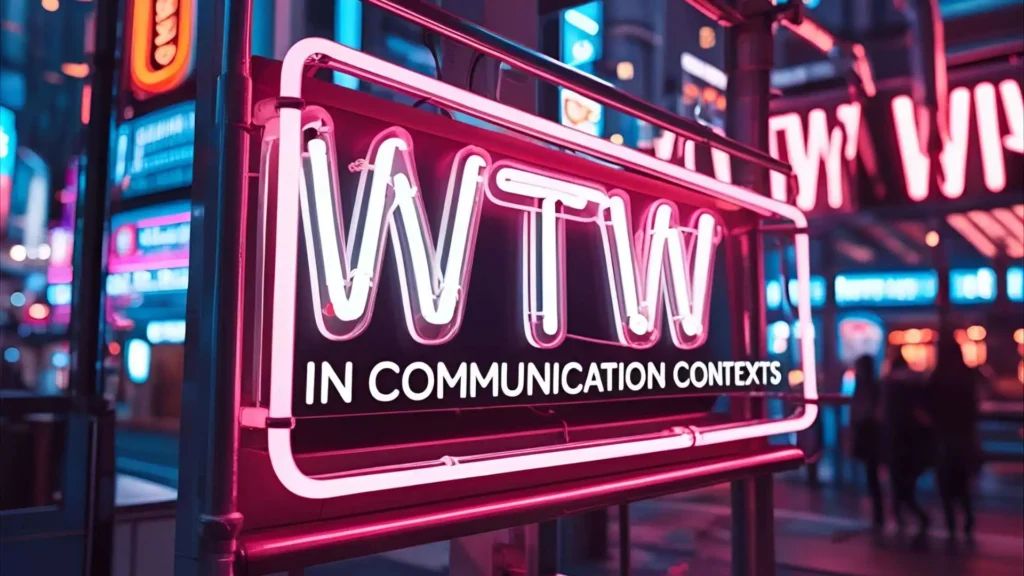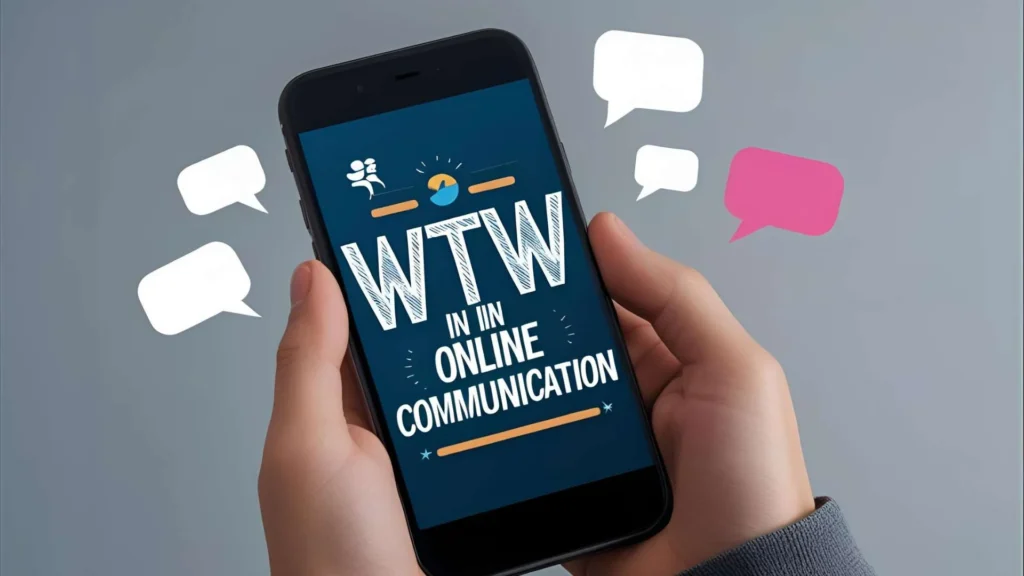The digital world loves shortcuts. Whether you’re scrolling through TikTok comments, snapping a friend, or chatting on Instagram, acronyms and abbreviations are everywhere.
One of the most common ones you might bump into is WTW.But what exactly does WTW mean?
Depending on the context, it could be a friendly greeting, an invitation, or even an expression of surprise. If you’ve ever gotten a text that just said “WTW?” and felt a little lost, don’t worry—you’re not alone.
In this guide, we’ll dive deep into the meaning of WTW, its usage across platforms, how to respond, and why it has become such a staple of online slang.
By the end, you’ll not only understand it but also be ready to use it naturally in your conversations.
What Does WTW Mean?
At its core, WTW has two main meanings in modern internet slang:
- “What’s the word?” → A casual greeting, similar to asking “What’s up?” or “How are you doing?”
- “What the what” → An expression of shock, disbelief, or surprise, often used when something unexpected happens.
These two uses may look different at first, but context usually makes the meaning clear.
Here’s a quick comparison:
| Acronym | Full Form | Meaning in Context | Tone |
| WTW | What’s the word? | Greeting / conversation starter | Friendly |
| WTW | What the what | Expression of surprise | Shocked |
So when you see WTW, don’t panic. Just look at the tone, punctuation, and situation—it will tell you whether your friend is saying “Hey, what’s up?” or “Wait, WHAT just happened?”
WTW in Communication Contexts

Like many acronyms, the meaning of WTW depends heavily on the context where it’s used. Let’s break down where you’re most likely to encounter it:
Texting & Instant Messaging
Text messages are the most common place for WTW. It’s short, quick, and gets the point across. If a friend texts you “WTW?”, they might be checking in on your plans, your mood, or simply starting a conversation.
Social Media Platforms
WTW has exploded in usage across social platforms:
- Snapchat → Used in chats, often to ask what someone’s doing or if they’re free to hang out.
- TikTok → Appears in captions or comments, either as a greeting or as a way to express shock at a funny or wild video.
- Instagram → Common in DMs and comments. A casual “WTW tonight?” could easily show up under a post about weekend plans.
Online Forums & Communities
Beyond one-on-one chats, WTW slips into group chats, Discord servers, and even online gaming lobbies. It acts as a low-effort way to engage, similar to saying “Hey everyone, what’s going on?”
Tone Flexibility
One of the most fascinating aspects of WTW is how punctuation changes the meaning:
- “WTW?” → A polite check-in or invitation.
- “WTW!!” → A shocked reaction, almost like saying “No way!” or “Are you serious?!”
This flexibility is part of why the acronym has stuck around—it fits multiple moods with minimal effort.
How WTW Functions in Language
WTW isn’t just shorthand; it actually plays several roles in digital communication.
- Greeting Expression → Works as a modern-day “hello” or “what’s up.”
- Casual Conversation Starter → Low-pressure way to open dialogue without needing a full question.
- Expression of Surprise → Doubles as a quick reaction to unexpected events.
- Contextual Nuance → The same three letters can mean two different things depending on the situation, punctuation, and sender relationship.
For example, a close friend might text you “WTW?” as a casual invite. But if they reply to your wild story with “WTW!!!”, they’re clearly shocked.
Example Usages of WTW

To make this crystal clear, let’s look at how WTW shows up in real conversations.
| Message Example | Interpretation | Best Reply |
| “WTW man? Haven’t seen you in ages.” | Greeting / casual check-in | “Not much, just working. You?” |
| “WTW tonight? Wanna go to the cinema?” | Invitation / plan-making | “I’m in! What time?” |
| “WTW! I can’t believe that happened.” | Expression of shock or disbelief | “I know, right?! Totally Unbelievable” |
| “Bro, WTW?? You didn’t tell me that!” | Surprise mixed with mild annoyance | “Haha, my bad. Forgot to mention.” |
| “Hey, WTW? Wanna grab food later?” | Friendly invite | “Sure! Let’s do it around 7.” |
How to Respond to WTW
Once you understand the context, responding to WTW becomes easy.
Neutral / Engaging Replies
These keep the conversation flowing without committing too much:
- “Not much. What about you?”
- “Just chilling, how about you?”
Polite Deferrals
Sometimes you’re busy. Here’s how to decline politely:
- “Quite busy right now. Talk later?”
- “At work at the moment. Hit me up later.”
Active Engagement
If you want to escalate the conversation:
- “It’s all happening right now. Wanna call?”
- “Just got off work—WTW with you? Wanna meet up?”
Top 5 Universal Responses to WTW:
- “Not much, what’s up with you?”
- “Chilling. You?”
- “Just got home. WTW with you?”
- “Free later if you wanna hang.”
These work across texting, Snapchat, Instagram, and even casual workplace chats.
Variations & Related Phrases
WTW isn’t the only greeting or shorthand used online. It has siblings in the slang family:
- “What’s up?” → Classic greeting.
- “How are you doing?” → Politer, slightly more formal.
- “Wyd?” (What you doing?) → More specific than WTW.
- “Sup?” → Quick and super casual.
Key Difference: WTW tends to be more versatile because it works both as a greeting and as an expression of shock.
Why WTW Matters in Online Communication

Why does a three-letter acronym matter so much? Because it reflects how modern communication is evolving.
- Speed and Brevity → People type fast, think fast, and want quick replies. Acronyms like WTW save time.
- Tone Management → Helps set a casual, approachable mood in texts.
- Social Connection → Makes it easy to start a conversation without overthinking.
- Cultural Trend → Fits into the broader rise of texting slang like “BRB,” “LOL,” and “SMH.”
In other words, WTW is more than just shorthand—it’s a social tool.
The Evolution of WTW in Slang Culture
Language on the internet evolves constantly, and WTW has carved out its spot in digital slang.
- 2000s → Early internet chatrooms and text messaging gave rise to acronyms like LOL, BRB, and OMG.
- 2010s → WTW gained traction on Snapchat and Instagram DMs as shorthand for greetings.
- 2020s → TikTok helped popularize “WTW” as both a greeting and a shocked reaction, making it mainstream.
Now, you’ll find WTW everywhere from casual chats between teenagers to memes circulating on Twitter.
Practical Tips for Using WTW Correctly
If you’re planning to use WTW in your own conversations, here are a few things to keep in mind:
- Know Your Audience → Younger audiences use it more frequently. Older recipients might not understand it.
- Mind the Tone → Don’t overuse exclamation points unless you really mean surprise.
- Keep It Casual → WTW works best in informal settings. Avoid using it in professional emails or serious conversations.
- Use It Naturally → If it feels forced, skip it. Slang should flow, not feel like homework.
Final Thoughts on WTW Meaning
So, what does WTW mean? At its simplest, it’s shorthand for “What’s the word?”—a friendly greeting. In other contexts, it becomes “What the what”, an expression of shock.
The beauty of WTW lies in its flexibility. It can open a conversation, set plans in motion, or express pure disbelief. Like many internet slang terms, it reflects the need for quick, casual, and expressive communication in a fast-paced digital world.
Next time someone texts you “WTW?”, you won’t be scratching your head. Instead, you’ll know exactly how to reply—and maybe even throw it into your own conversations.

Mariah Cannon is the creative mind behind Pikuplab.com, crafting engaging, high-ranking content with expertise and precision.
With a talent for turning ideas into impactful words, Mariah brings value to every article.

